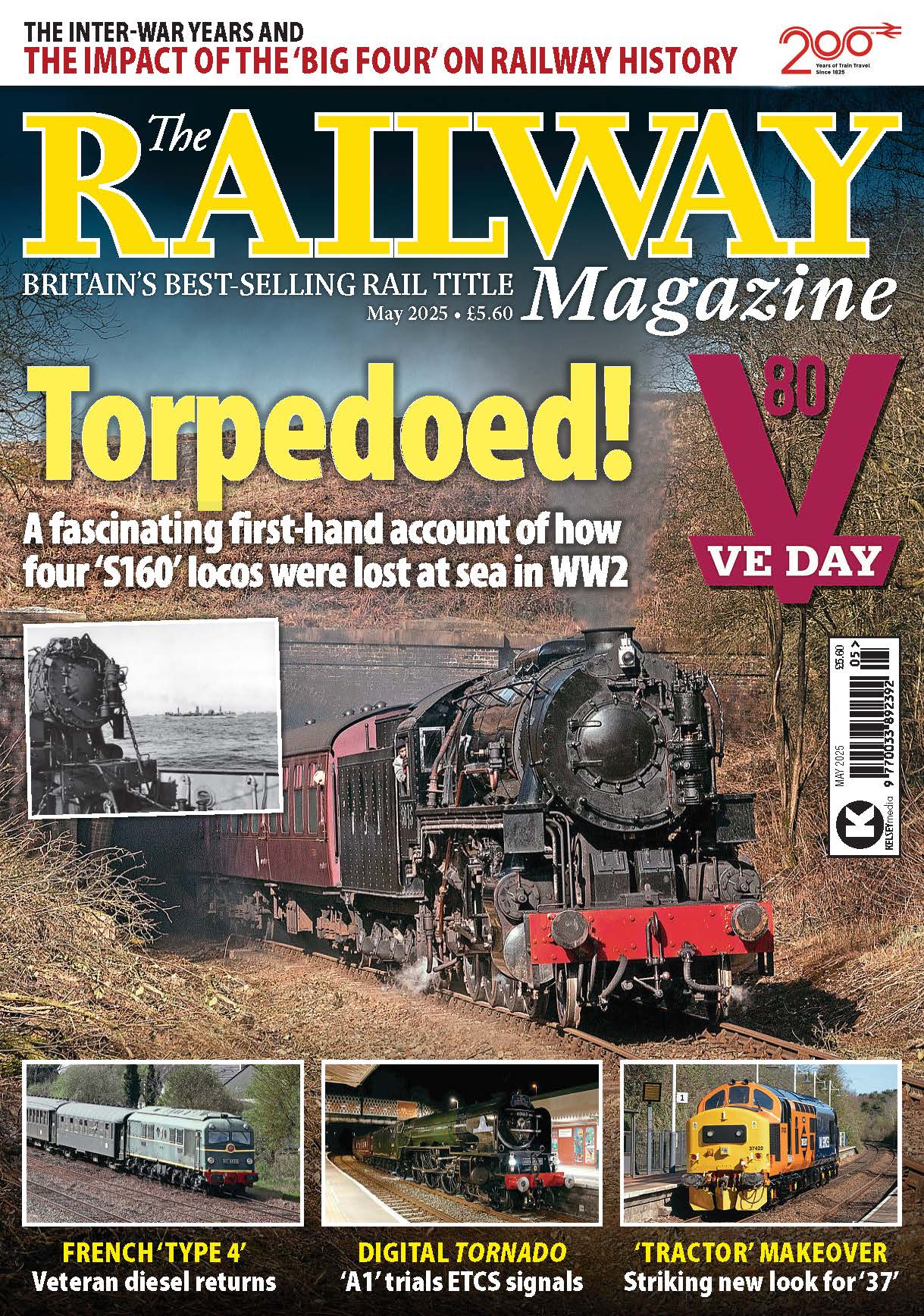Half a century has now passed since a group of like-minded individuals got together in early 1967 to take over the operation of a former colliery branch.
In those 50 years the Foxfield Railway has seen many changes, but has remained faithful to its original aim of preserving and operating locally connected industrial locomotives, as Gary Boyd-Hope explains.
Picture the scene. You are standing in a Staffordshire field beneath an almost cloudless blue sky.
Monthly Subscription: Enjoy more Railway Magazine reading each month with free delivery to you door, and access to over 100 years in the archive, all for just £5.35 per month.
Click here to subscribe & save
Ahead of you, about 50ft away, is a line of grassy scrub and a wire fence that marks a railway boundary; the formation itself rises steadily from the right of your vision to the left. All is quiet. Just the occasional bird call or buzzing of a fly disturbing the peace of this fine July day.
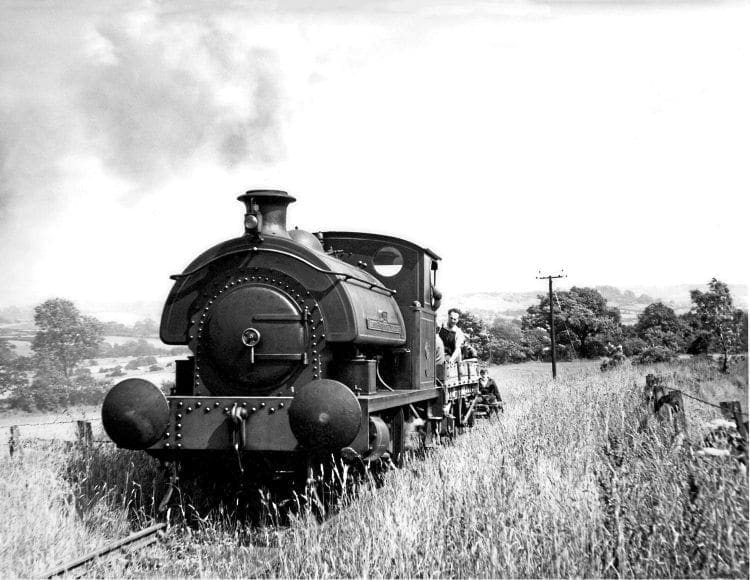
Suddenly, from somewhere out of view behind the trees to your right, comes the piercing shriek of a locomotive whistle to shatter the tranquillity. This is it. This is what you’ve been waiting for.
A single bark of exhaust follows, then another, and another, and you hear the tell-tale ‘ching…ching…ching’ of loose couplings suddenly tightening.
The exhaust beat grows stronger, sharper and quicker – too quick as the loco loses its footing and momentarily slips before the skilful driver regains control.
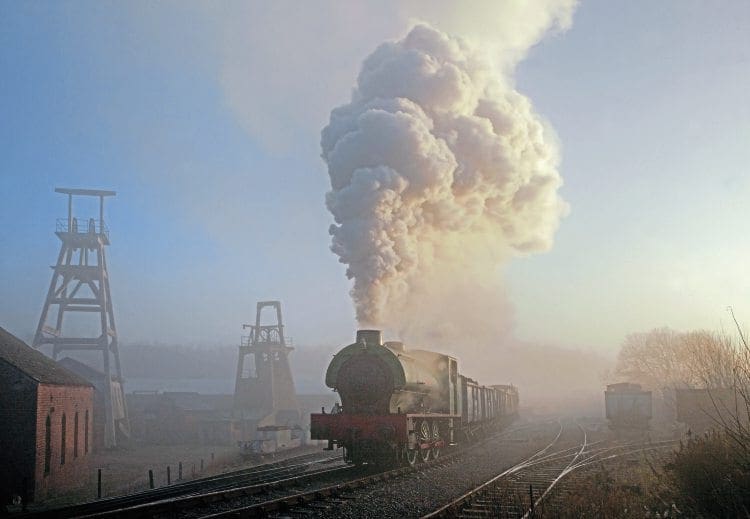
So far this is a purely an audial experience for you in your field, but your eyes are fixed on the trees on your right as you wait for what comes next. Then you see it above the tree line – a column of grey/white smoke blasting into the air like the pyroclastic cloud of an erupting volcano.
The column gets closer and the exhaust louder when, out from behind the trees, emerges a bright blue ‘Austerity’ 0-6-0ST spitting fire and brimstone high into the air.
As it starts to pan across your field of vision you count the 16-ton coal wagons behind it as each appears – one, two, three…..six in total, with a brakevan on the rear.
The distinctive blue livery of the ‘Austerity’ identifies it as ex-Cannock Wood Colliery No. 7 Wimblebury, and as it passes your vantage point you spot the fireman looking solemnly at the exhaust, as he’s bidding farewell to the fire he built only a few moments before.
And then it’s all over. The driver shuts off a little and Wimblebury and its train disappear from view on your left.
You can still hear it as it climbs the last leg into Dilhorne Park loop, and as you turn away you catch a glimpse of the many other observers, photographers and videographers who have shared the experience with you. Like you, all are smiling.
Who can blame them? You have all just witnessed steam on Foxfield bank, arguably one of the finest spectacles in UK steam preservation and something unique to the Foxfield Railway, which this year is celebrating its 50th anniversary.

Industrial roots
The Foxfield Railway as we know it today can trace its origins back to the opening of Foxfield Colliery by John and Enoch Mann in the early 1880s.
Their enterprise was registered as a private company – Foxfield Colliery Co Ltd – in May 1893, and in that same year Messrs Mann opened a 3½-mile standard gauge branch linking the colliery with the North Staffordshire Railway (NSR) at Blythe Bridge, on the Derby to Stoke-on-Trent line.
The new railway was built through a picturesque area, largely comprising woods and farmland, by NSR employees at weekends, and mainly using second-hand material supplied by the ‘Knotty’.
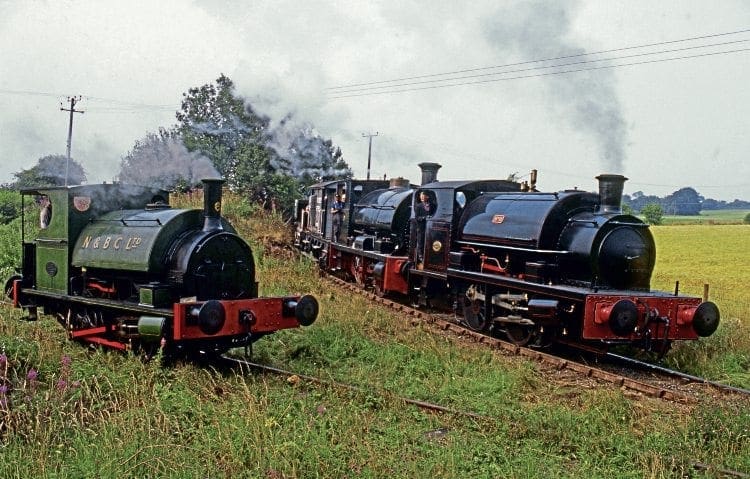
It was, and remains, notable for its ferocious gradients, in particular the section of 1-in-19 leading out of the colliery onto Foxfield bank.
This was a result of frugal spending by the colliery’s owners, who wished to keep earthworks (and expenditure) at a minimum, and also in part to a local landowner who did not want the railway running through his property, thereby necessitating a deviation by way of Dilhorne Wood.
This resulted in the line looping around to enter the colliery from the north rather than from the Blythe Bridge end to the south. The total cost of building the new line was just £3,000.
The purpose of the new branch was purely to ship coal from Foxfield to the transhipment sidings at Blythe Bridge, with a landsale wharf opening at Cash Heath on Caverswall Road close to where the line began its descent to the junction with the main line.
Additionally, a narrow gauge branch ran northwards from a point close to the current Dilhorne Park station to Bank Top (later converted to standard gauge), while a second narrow gauge tramway ran eastwards from the colliery in the direction of Cheadle, terminating about a mile distant at Adderley.
The Foxfield Colliery branch fulfilled its purpose admirably from its opening until the closure of the colliery in the mid-1960s, witnessing two changes of ownership during that time.
In 1927 the Foxfield Colliery Co went into liquidation and the colliery was sold to Parkhall Colliery Co Ltd, which in turn was absorbed into the new National Coal Board on January 1, 1947.
Apart from the closure of the Cash Heath Wharf in 1949, life on the Foxfield branch was fairly uneventful.
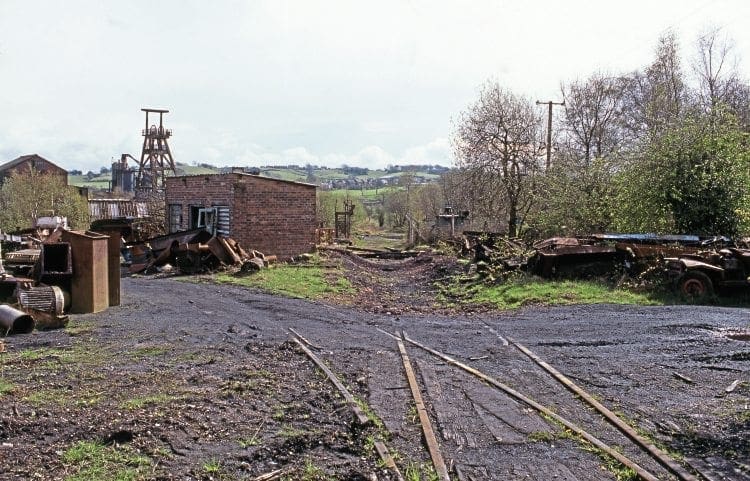
Porcelain, Pecketts and a cleric
That changed in 1965 when the NCB elected to close the low-yielding colliery, transferring its miners to Florence Colliery instead.
The resident Coal Board rolling stock, which included ‘Austerity’ 0-6-0STs and an ageing Manning, Wardle, was dispersed and the colliery land and railway put out to grass and up for sale.
It was bought by Tean Minerals Ltd with the intention of turning the colliery site into a mineral processing plant.
The company, under the chairmanship of Stuart Wetherby and management of Ted Trubshaw, specialised in the dry grinding of flint, which it then sold into Stoke-on-Trent’s porcelain industry.
Both Wetherby and Trubshaw were steam men with strong associations with the road steam movement, and were of the opinion that the Foxfield branch could be used for the transfer of minerals to and from the old colliery.
The fly in the ointment to this idea was the quantities of material being talked about.
Tean Minerals was not a high-output producer, and it would take considerable effort and expense to make the near-derelict railway serviceable again; something potentially difficult to justify for maybe one train a week.
Thanks to their steam leanings both Wetherby and Trubshaw were familiar with the growing interest in preserving old railways, and soon Ted Trubshaw was formulating an idea for something similar with the Foxfield branch.
The idea gathered momentum and a meeting was called on October 30, 1966 by one Wilfred Oakes, who invited 85 people to come and hear the proposal for a new Foxfield railway society. A total of 63 attended, enjoying tea and sandwiches courtesy of Tean Minerals.
The proposal put forward was that the new society would maintain the infrastructure and provide the volunteers to run steam passenger trains at weekends, while Tean Minerals used the line for mineral traffic during the week.
It was agreed to form a committee that would investigate the formation of a railway society, but fast action was required as the group had got wind that Peckett 0-4-0ST Henry Cort might be available because its owner Richard Thomas & Baldwins was looking to donate it to a suitable home for preservation.
The 1903-built loco had previously been employed at Irthlingborough Quarry in Northamptonshire, but following the closure of the quarry in 1965 had lain out of use in the system’s shed.
The problem was that the fledgling Foxfield Light Railway Society (FLRS) had no official standing or constitution – it only had eight paid-up members, who made up the committee – so it was agreed that the group would be affiliated to the Railway Preservation Society at Hednesford, which would take on the Peckett if the Foxfield endeavours collapsed.
Thanks to the efforts of the well-known ‘steam cleric’ the Rev E R ‘Teddy’ Boston, Henry Cort was given to the FLRS and it arrived at Foxfield on February 5, 1967.
Interestingly, when it arrived, the Peckett was unloaded downhill of the old colliery engine shed, and therefore had to be steamed in order to get it into the shed – the first locomotive to steam on site since NCB days.
Of note was the downward grade leading into the old shed, descending at a fearsome 1-in-11.

ROBIN STEWART-SMITH
A week later, on February 12, the inaugural general meeting of the FLRS was held in the old colliery canteen at Foxfield to formally accept the memorandum and articles of association of the society.
Some 64 of the 100 invitees attended, with more than 50 signing up as members there and then.
As things played out, the grand plan to run mineral trains came to nought, but the FLRS was born and, with Stuart Wetherby as president and Wilfred Oakes as chairman, moves were afoot to get a trains running again at Foxfield.
Having the Tean Minerals directors as part of the team was certainly a bonus and the society was given full use of the old colliery site, enabling it to begin the process of stock acquisition.
As work on overhauling the Peckett got underway, another 0-4-0ST arrived, this time fresh from the brewery railways of Burton-upon-Trent. Marston, Thompson & Evershed No. 3 was built in 1924 by Hawthorn Leslie, and is always recognisable in early Foxfield images thanks to its huge nameplates, which are almost as long as the locomotive’s tank.
The two steam locomotives had arrived at the Tean Minerals site by road, but the first item of passenger stock reached the railway by way of its main line connection.
Ex-LMS Vestibule Third No. 27249 had been bought thanks to a £260 loan from society members and was delivered to its new home via the exchange sidings at Blythe Bridge.
Together with the two steam locos the coach formed the first passenger train to be worked by the FLRS, just four months after the formal establishment of the society.
The date was May 14, 1967 and a large gathering of the FLRS’ 50-plus members and friends were present to witness the occasion.
With Henry Cort leading and Marston, Thompson & Evershed No. 3 assisting at the rear, the short ensemble covered the full length of the line from the colliery to the exchange sidings, ushering in a new era of railway preservation for the region.
Five decades on and the ‘first train’ stock is still resident on the railway, although the Hawthorn Leslie did leave for a few years before coming ‘home’.
Better still, several of the members who were present that day are also still actively involved with the railway, having seen many changes along the way.
More locos than stock
From that historic May day the Foxfield Railway continued to work on improving the permanent way and steadily began to amass a collection of industrial locomotives at the colliery.
Steam days were usually held on the second Sunday of each month, typically with three or four locos in steam.
A platform was built at the bottom of the colliery yard and passengers were conveyed up the bank using a variety of means, including brakevans, former scenery vans (ex-Boots, Nottingham) and open or flat wagons with seats or benches sitting loose; the LMS coach was largely reserved for special occasions.
From day one the society wanted to stay true to the railway’s industrial roots and there was no place on the Foxfield Railway for ex-main line motive power (in spite of Ted Trubshaw wanting to bring a Stanier ‘Black Five’ to the line).
That aim quickly evolved further, whereby locos and stock acquired for the line should have Staffordshire connections – either being locally built or locally used, a collecting ethos that remains true today.
By the end of the 1960s the loco fleet had swollen with the arrival of Bagnall 0-4-0ST J T Daly, Peckett 0-4-0ST No. 11, Robert Stephenson & Hawthorns 0-6-0ST No. 39, Manning, Wardle 0-6-0ST No. 35, Simplex 4wDM Helen and Bagnall 0-6-0ST Lewisham.
Within a couple of years Hunslet 0-6-0ST Robert Nelson No. 4, Manning, Wardle 0-6-0ST Littleton No. 5 and unique Bagnall 0-6-0ST Topham had also joined the fold, and it is fair to say that the railway was overrun with locomotives to the degree that it had more on site than it did rolling stock.
By 1970 the Tean Minerals dream of using the railway to bring in raw materials and ship out processed products still had not progressed beyond the ideas stage.
At that time British Rail was relaying the main line through Blythe Bridge and, having decreed that any potential mineral traffic would be too inconsequential to warrant retaining the connection, removed the junction and severed the Foxfield branch from the national network.
Losses and gains
Throughout the 1970s the Foxfield Railway built upon those early foundations, running steam from a new platform by the colliery entrance to Blythe Bridge.
Before the decade had reached its mid-point, four locomotives (Robert Nelson No. 4, Littleton No. 5, Marston, Thompson & Evershed No. 3, and the RSH No. 39) had departed for the Great Central Railway revival scheme at Loughborough, and others had arrived, including ‘Austerity’ 0-6-0ST Wimblebury, ex-Doxford 0-4-0CT Roker and Bagnall 0-4-0ST Harwarden.
One of the great successes of the period were the ‘Wine & Dine’ trains, featuring the LMS coach and one of the Boots vans, converted into a kitchen car.
These proved very lucrative, and brought in revenue that would later prove invaluable.
Brian Allen, who was one of the founding members and today acts as the society’s president, recalls: “The ‘Wine & Dine’ trains were a great success for us and in fact helped pay for the land at Caverswall Road, where the station now stands.
However, we always had to be aware of the line’s gradients and could not serve the soup until we’d reached to top of Foxfield bank!”
Few of those founder members could have envisaged how quickly the Foxfield Railway would grow in those first few years.
The growing collection had seen them move from the triangle section in the middle of the works to the bottom colliery yard, then the removal of the old colliery spoil heap required the collection to be moved again, this time to temporary sidings on a rented piece of land in Foxfield Wood, next to the railway.
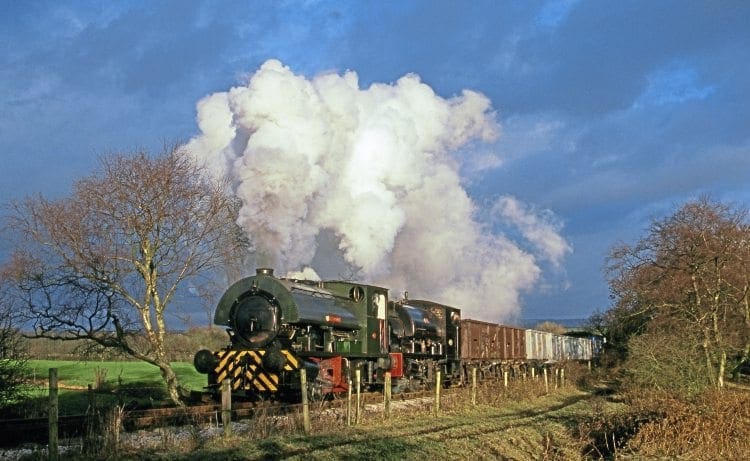
However, Tean Minerals had a business to run and the simple fact was that the expanding railway operation was no longer compatible with the works.
The loss of the main line link had also left the company with a railway that it didn’t really need, so the directors offered to sell the line to the FLRS for the bargain price of £10,000, but with one exception: the sale would not include the section of railway through the colliery as it would have severed the works in two.
The sale offer was accepted and the society obtained a mortgage for the asking price. Yet it marked the end of an era, spelling the end for passenger trains up the bank and effectively leaving the railway without a base of operations.
The days of running right down to the Blythe Bridge end were also numbered as the decade progressed and the railway became a victim of its own success.
Access to the southern terminus involved a tight seven-chain radius curve, which had not been built with bogie coaches in mind. While the LMS coach could just about negotiate the curve, the arrival of ex BR Mk1s in around 1974 presented a different picture as these could not cope with the curvature.
With the Blythe Bridge terminus effectively redundant and the Foxfield end out of bounds, the railway was desperate for better accommodation than the sidings at Foxfield Wood.
Thus, as already mentioned, in 1979 the FLRS acquired a section of land on the site of the old Cash Heath Wharf for the princely sum of £285, using proceeds from the ‘Wine & Dine’ trains.
Gradually the site was developed and a new shed building erected, but in the words of another founder member, Dave Donkin, “it was like starting all over again”.
The former Hockley Crossing signalbox arrived during the development work, although it would be some time before it was erected.
However, work had progressed well enough on the rest of the site to enable the first trains to run from a new platform in 1981.
Today the Caverswall Road site has grown still further to incorporate a refreshment room, real ale pub (The One Legged Shunter), shop, museum, workshop (provided by Mr Kipling, the bakers), two-road loco shed (the Jack Hollick building), car park, overflow car park, and the 7¼in-gauge Foxfield Miniature Railway.
During the early 1980s Tean Minerals called time on the mineral business at Foxfield, and sold the site to Fergusson Wild & Co.
Before they did, however, they offered to sell the old railway formation through the colliery to the society, with additional land for a new station and run-round loop. £12,000 later and the Foxfield Railway had access to the colliery once more, much to the chagrin of the site’s new owners.
“We were very lucky to get the colliery land,” says Dave Donkin. “Thankfully the Tean Minerals directors were sympathetic to what we were doing and their offer really opened the way back up for the use of Foxfield bank. It was a key moment in the society’s history.”
Throughout this period the bank had seen little use, the railway having cut back its operations to the loop platform at Dilhorne Park for ease of running round the longer two-coach trains.
Progressively, work on making good the formation through the colliery got underway, excavations were filled in, an embankment created, and track started to be re-laid. A new era had begun.
The story up to date
Regular Foxfield spokesman Dave Scragg describes the railway of the late 1980s as “humdrum”, when the focus was on consolidation and the railway was doing little of what you would describe as exciting.
“The problem was that although we were a genuine industrial railway running industrial steam engines on Mk1 stock, a number of other preserved lines had developed over the years and they too were using industrials on Mk1 stock.
“While industrials were our primary focus, to them they were just a means to an end, but suddenly we found ourselves being no different from the rest. We needed to find our identity again.”
The key to this was Foxfield bank and the pure theatre it provides. The RM’s own Chris Milner, together with Robin Stewart-Smith, had virtually pioneered the photographic charter, taking Foxfield locos to Littleton Colliery twice and later to Shelton Steelworks among others, and the railway simply tapped into that market.
Around half a dozen wagons were acquired from Chatterley Whitfield Mining Museum, and the collection grew to include 15 16T mineral wagons (nicknamed the ‘Windbreaker’ in homage to the Great Central’s ‘Windcutter’) and 12 21T hoppers.
Steam on the bank became a regular sight as the charter market grew, and it was this success that led to the idea of doing something similar at galas.
Why limit the spectacle of colliery steam storming up the 1-in-19 to charters only, when you could make it a feature of your gala event?
The decision put the railway’s July Summer Gala on the map, and over the years the likes of Dave Scragg and Richard Barnett have arranged for a range of appropriate engines to visit the line specifically for the gala.
The event attracts people from all over the country, and with a couple of charters invariably thrown in, the July gala is a ‘must’ in the annual steam calendar.
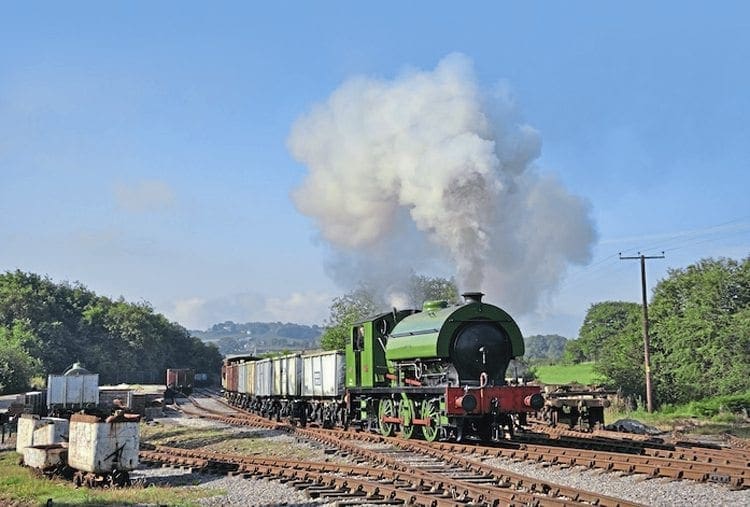
And it’s not just charters and galas that have proved popular. The annual ‘Santa Special’ season goes from strength to strength to the point where it has become the lifeblood of the railway, while the more recent ‘Knotty Heritage Train’ is also proving to be a draw.
The Foxfield-affiliated Knotty Heritage Trust has already funded the restoration of two North Staffordshire Railway four-wheelers, and is currently looking to roll out a Third Class brake coach, modified for disabled access.
A fourth vehicle, this time First Class, has been sent for assessment, potentially taking the rake to four.
About 20 years ago the society was presented with the opportunity to acquire additional land near the colliery, including some of the woodland and settling ponds.
Then in June 1999 the news came that the Heritage Lottery Fund had awarded the railway nearly £500,000 to carry out essential works to the colliery site, restore the larger of the two headstocks, relay the bank, and build a shed and platform at the bottom of the yard.
The money ran out before the shed was completed and only the lower portion of the walls were built, but the FLRS now had full use of the colliery, paving the way for the next stage in the railway’s development.
Passengers up the bank?
As the Foxfield Railway celebrates its 50th anniversary, thoughts will inevitably turn to the future and what it might have in store.
It has been a long-term goal of the society to once again work steam-hauled passenger trains up Foxfield bank, and the project has had a number of false starts.
Modern regulation now means that you cannot just go ahead and do it on those sorts of gradients – unlike back in the early days of the society – and the railway has been working closely with the rail regulator to ensure that the operation will be safe. If all goes to plan, passenger trains from the colliery could begin next year.
The project is being managed by Jonathan Adshead, who is overseeing the equipping and installation of two groundframes – one at Dilhorne Park and the other at the colliery – that will control operations.
“We’ve got to have interlocking on facing points and will only be able to have one train in section at any one time,” Jonathan explains. “We also need to lay two new sidings in order to free up the platform road as that’s where we store wagons, but once the infrastructure is in place we can get on with the all-important crew training. We are aiming to have the colliery as part of the timetable in 2018.”
Like the Knotty train, the railway wants to ensure that passenger trains up the bank remain something special, and it is likely that these will perhaps only run once a month.
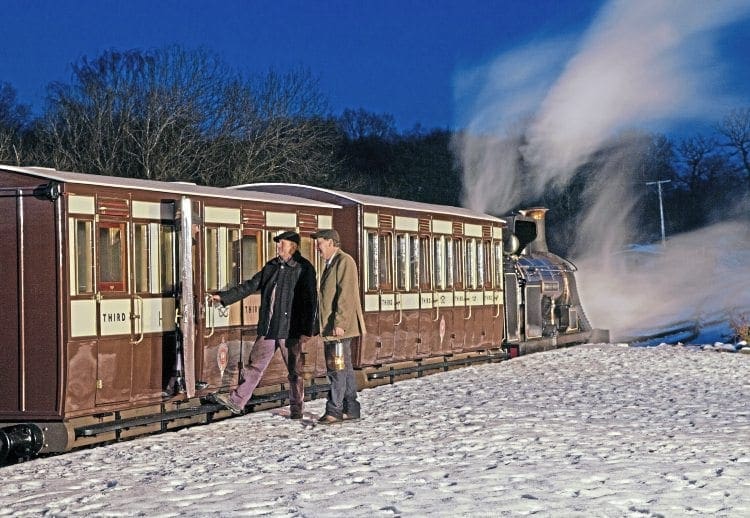
The colliery itself is really the jewel in the Foxfield Railway crown; how many preserved railways can boast a colliery complex? Further work is ongoing to improve the visitor experience to the site, while retaining the industrial atmosphere.
For example, there is an aspiration to have a colliery winding engine installed, while the semi-completed shed will be finished and the platform improved, maybe with a North Staffordshire Railway-type halt shelter.
After all, the railway’s NSR four-wheelers would be well-suited to working up the bank, more so perhaps than the longer Mk1s.
The Knotty train itself has added a new element to the Foxfield offering, but the planned expansion of the heritage train brings its own problems.
Covered accommodation is lacking; the running shed can accommodate four locos and the workshop another two, but the remaining covered space is taken up by the museum. Clearly, the beautifully restored Knotty set cannot be left in the open, so it is stored in the museum when not in use.
However, this is full to capacity and the railway desperately needs a carriage shed to house not only the Knotty train but also additional items that are suffering the effects of outdoor storage.
The problem was highlighted as recently as April 29 when arsonists torched some wooden-bodied wagons that were in store in the Blythe Bridge sidings, having already had a go on the previous Tuesday. The wagons were in dire need of restoration and in a poor state of repair, but the fire has removed any possibility of salvaging any useful timbers.
Consequently a Crowd Funding appeal has been set up to try and raise £39,998 to build a dedicated stock shed. A site has been earmarked at Caverswall Road, but any progress will be entirely down to whether the finance is available.
And what of the line from Caverswall Road down to Blythe Bridge? Could it be brought back into use?
“We will only look at how we could reintegrate the Blythe line with the rest of the railway once the colliery is completed,” answers Dave Scragg. “But is it an aspiration for the next five years? I would have to say yes!
“How we do it and eventually use it remains to be seen, but I can see it becoming part of the gala experience in the way that the bank is now.”
From an engineering point of view the Foxfield Railway has never stood still, and while some of the early locomotives have moved on (Topham, J T Daly and No. 35, to name a few), others have returned or joined the fold afresh.
For example, the railway is the official home of the Vintage Carriages Trust’s Haydock Foundry 0-6-0WT Bellerophon, which has been designated the official Knotty Heritage Train engine.
Dübs 0-4-0CT No. 4101 was restored at the railway by Dave Scragg and is currently the UK’s only operational crane tank, while Bagnall 0-4-0ST No. 2842 and RSH 0-4-0ST Eustace Forth, the latter formerly part of the National Collection, have been restored by the Civil family.
Another ex-National Collection loco – North Staffordshire Railway 0-6-2T No. 2 – was gifted to the society in 2016, and it is hoped that the loco, which spent most of its working career in industrial service at Walkden, Lancashire, could be returned to steam one day, if funding becomes available.
The ever-popular Wimblebury is expected to return to service imminently after overhaul, Beyer, Peacock 0-4-0ST No. 1827 should return later this year, while ex-Shelton Steelworks Bagnall 0-4-0ST Harwarden is expected back in traffic in 2018.
The erstwhile Marston, Thompson & Evershed No. 3 returned to the railway in 1996, and is currently undergoing a major overhaul, while Dave Donkin has begun the overhaul of his Giesl ejector-fitted Bagnall 0-6-0ST Florence No. 2.
The majority of the loco fleet is privately owned, and in 2015 the FLRS took the decision to acquire a locomotive of its own.
Peckett 0-6-0ST Ackton Hall No. 3 needs a ‘nut-and-bolt’ restoration that will include the renewal of most of the upper structure, but when completed it will form the basis of a pre-NCB coal train to not only complement the Knotty train, but also the later 16T wagons that are the current stars of the charter market.
Brian Allen, who in 2000 was awarded an MBE for his services to the Foxfield Railway, says that he is very proud of the railway and what it has achieved in 50 years. It has certainly triumphed in the face of adversity and overcome hurdles, while sticking true to its ethos set out all those years ago.
The Railway Magazine Archive
Access to The Railway Magazine digital archive online, on your computer, tablet, and smartphone. The archive is now complete – with 122 years of back issues available, that’s 140,000 pages of your favourite rail news magazine.
The archive is available to subscribers of The Railway Magazine, and can be purchased as an add-on for just £24 per year.
Existing subscribers should click the Add Archive button above, or call 01507 529529 – you will need your subscription details to hand.



